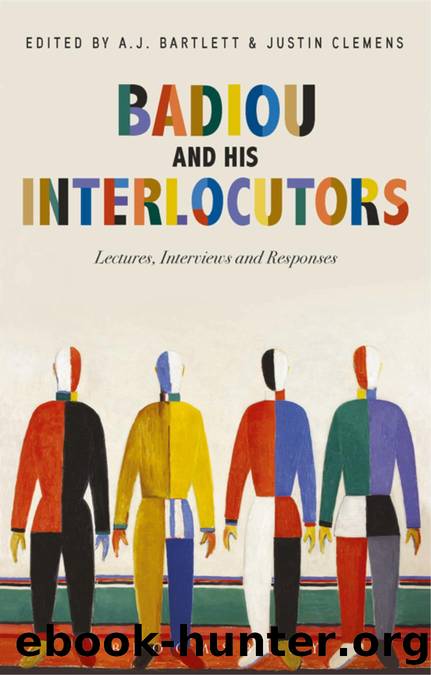Badiou and His Interlocutors by Alain Badiou;A.J. Bartlett;Justin Clemens;

Author:Alain Badiou;A.J. Bartlett;Justin Clemens;
Language: eng
Format: epub
ISBN: 9781350026643
Publisher: Bloomsbury UK
Published: 2019-11-22T00:00:00+00:00
The treatment of waste
Placing momentarily to one side this âidealizationâ of cinema, it is necessary to emphasize another aspect of cinemaâs impurity, namely, its non-artistic side, which relates to its peculiar status as a âplace of intrinsic indiscernibility between art and non-artâ (IT 111). In a nutshell, cinema figures for Badiou as an art that remains in an important sense âbeneathâ art. Indeed, Badiou explicitly holds that âno film strictly speaking is controlled by artistic thinking from beginning to end. It always bears absolutely impure elements within it, drawn from ambient imagery, from the detritus of other arts, and from conventions with a limited shelf lifeâ (IT 111). Or as he puts it elsewhere (in relation to Platoâs theory of Forms), âif cinema is⦠the chance visitation of the Idea, it is in the sense in which Plato has the old Parmenides demand of the young Socrates that he accept, together with the Good, the Just, the True, and the Beautiful, other equally abstract though less respectable ideas: the ideas of Hair, or of Mudâ.18
What this of course means is that â at least in the case of cinema â non-art is immanent to art as a rule. Not only is every film, in the final analysis, a commodity circulating in a global market, which is produced by a certain number of labourers, and manufactured within a specific system of economic and ideological relations; moreover, the voracious relation of the camera to the real means that no film can truly shield itself from the stock images of the time. It is with this in mind that Badiou proclaims that âwith only slight exaggeration cinema could be compared to the treatment of wasteâ (CMA 226). Indeed, insofar as cinema figures as something of a grey area between art and non-art, Badiou contends that any properly artistic activity in cinema â that is, the effective passage of a cinema-Idea â can only be discerned as a âprocess of purification of its own immanent non-artistic characterâ (IT 111). Which is to say that, for a film to be truly artistic, an (effectively interminable) process of purging must first take place. And yet, Badiou quickly concedes, such an absolutely purificatory process can of course never be actually achieved. At best, such a âpureâ cinematic ideal might only be approached asymptotically. âThis impossibilityâ, Badiou declares, âis the real of cinema, which is a struggle with the infinite, a struggle to purify the infiniteâ (CMA 227). To this effect Badiou concludes that âcinemaâs artistic operations are incompletable purification operations, bearing on current non-artistic forms or indistinct imageryâ (IT 111).
Now, while it might seem that cinemaâs necessary non-artistry forecloses from the start any possibility of its attaining true (or âpureâ) artistic status, again, the paradox is that, according to Badiou, it is precisely in maintaining a degree of non-artistic content that cinema is guaranteed a certain artistic capacity. For as Badiou sees it, an absolute purification of cinemaâs non-artistic content would actually work to suppress its artistic
Download
This site does not store any files on its server. We only index and link to content provided by other sites. Please contact the content providers to delete copyright contents if any and email us, we'll remove relevant links or contents immediately.
The Power of Myth by Joseph Campbell & Bill Moyers(925)
Half Moon Bay by Jonathan Kellerman & Jesse Kellerman(911)
A Social History of the Media by Peter Burke & Peter Burke(883)
Inseparable by Emma Donoghue(844)
The Nets of Modernism: Henry James, Virginia Woolf, James Joyce, and Sigmund Freud by Maud Ellmann(740)
The Spike by Mark Humphries;(719)
A Theory of Narrative Drawing by Simon Grennan(707)
The Complete Correspondence 1928-1940 by Theodor W. Adorno & Walter Benjamin(705)
Ideology by Eagleton Terry;(659)
Bodies from the Library 3 by Tony Medawar(649)
Culture by Terry Eagleton(646)
World Philology by(645)
Farnsworth's Classical English Rhetoric by Ward Farnsworth(641)
A Reader’s Companion to J. D. Salinger’s The Catcher in the Rye by Peter Beidler(614)
Adam Smith by Jonathan Conlin(608)
High Albania by M. Edith Durham(592)
Game of Thrones and Philosophy by William Irwin(592)
Comic Genius: Portraits of Funny People by(581)
Monkey King by Wu Cheng'en(577)
